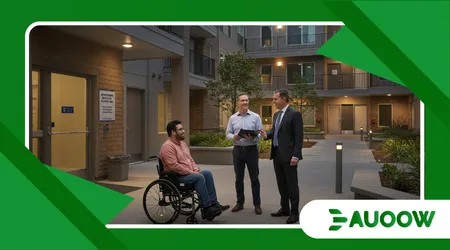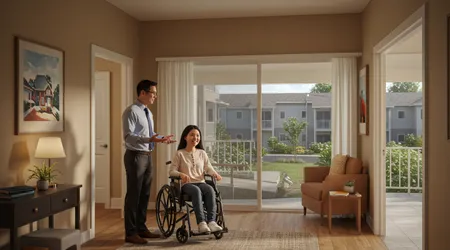Accessible Housing Laws: What Tenants with Disabilities Need to Know

Accessible housing laws shape the foundation of fair and inclusive living for tenants with disabilities, ensuring equal access to safe, functional homes.
These regulations, rooted in decades of civil rights advocacy, empower individuals to live independently and with dignity.
In 2025, with housing crises intensifying globally, understanding these laws is more critical than ever. They not only protect tenants but also compel landlords and housing providers to adapt spaces for accessibility.
This article dives deep into the intricacies of accessible housing laws, offering tenants practical insights, real-world examples, and actionable steps to navigate their rights in an ever-evolving legal landscape.
Imagine a door too narrow for a wheelchair or a landlord refusing a service animal barriers like these persist, but accessible housing laws exist to dismantle them.
From federal mandates like the Americans with Disabilities Act (ADA) to state-specific regulations, these laws address physical and policy-related obstacles.
This guide unpacks key protections, recent updates, and practical advice for tenants with disabilities. Why should you care?
Because knowing your rights can transform your living experience from frustration to empowerment.
The Bedrock of Accessibility: Key Laws and Their Scope
The Americans with Disabilities Act (ADA), enacted in 1990, prohibits discrimination in housing, employment, and public spaces.
Title II and III of the ADA mandate accessibility in public and private housing. The Fair Housing Act (FHA), amended in 1988, further ensures that landlords cannot deny tenancy based on disability.
These accessible housing laws apply to most housing types, including rentals and public units.
In 2025, the FHA continues to protect against discriminatory practices like refusing reasonable accommodations.
For example, a tenant with mobility issues can request a closer parking space.
++ Prison Reform and Disability: An Overlooked Civil Rights Issue
The ADA complements this by requiring physical accessibility, such as ramps in multi-family buildings. Together, these laws create a robust framework for inclusion.
Recent updates strengthen enforcement. In California, AB 2353 (2024) allows nonprofit developers to defer property taxes, easing affordable accessible housing projects.
This reflects a growing focus on accessibility in policy-making. Tenants must understand these laws to advocate effectively for their needs.

Reasonable Accommodations and Modifications: Your Rights Explained
Reasonable accommodations involve policy changes, like waiving pet fees for service animals. Accessible housing laws mandate landlords to grant these unless they cause undue hardship.
Modifications, like installing grab bars, are physical changes tenants can request. Landlords must allow these, though tenants may bear costs.
Consider Sarah, a Seattle tenant with arthritis. She requested a landlord install a ramp. Under accessible housing laws, the landlord complied, ensuring her safe entry.
Tenants must submit formal requests, often in writing, detailing their needs. This process ensures legal clarity and accountability.
Read more: How Inclusive Education Benefits All Students -Not Just Those with Disabilities
In Los Angeles, the Accessible Housing Program (AcHP) supports tenants in requesting modifications. Nonprofits like Bet Tzedek offer legal aid for disputes.
Knowing these resources empowers tenants to navigate complex housing systems with confidence and clarity.
Recent Legislative Changes: What’s New in 2025
In 2025, accessible housing laws evolve to address modern challenges. California’s SB 1211 allows more Accessory Dwelling Units (ADUs) on multifamily properties, enhancing housing options.
This law increases flexibility for tenants needing accessible units in urban areas.
Another update, the UK’s Renters’ Rights Bill, extends Awaab’s Law to private rentals, mandating timely fixes for hazards like mold.
Though UK-specific, this reflects a global push for safer housing. Tenants globally can draw inspiration from such reforms to demand accountability.
HUD’s 2025 plan to develop housing on public lands prioritizes accessibility, streamlining regulations for nonprofits. These changes signal a shift toward inclusive urban planning.
Tenants should monitor local policies to leverage new opportunities for accessible living.
Navigating Challenges: Common Barriers and Solutions
Despite accessible housing laws, barriers persist. Some landlords resist accommodations, citing costs or aesthetics.
Others fail to maintain accessible features, like broken elevators. Tenants can file complaints with HUD or local agencies to enforce compliance.
Take James, a visually impaired tenant in Oakland. His landlord refused to provide braille signage.
After contacting the city’s ADA Programs Office, James secured the signage. Accessible housing laws empower tenants to challenge such violations through legal recourse.
Education is key. Tenants should document requests and issues, maintaining clear communication with housing providers.
Local advocacy groups, like the Equal Rights Center, offer guidance. Staying informed ensures tenants can overcome obstacles effectively.
Practical Steps for Tenants: Advocating for Your Rights
Start by researching local accessible housing laws. In Seattle, the Housing Authority provides resources on filing discrimination complaints.
Tenants should submit detailed accommodation requests, citing specific needs and legal protections.
Engage with advocacy organizations. The Disability Rights Education and Defense Fund (DREDF) offers tools for navigating housing disputes.
Document all interactions with landlords to build a strong case if legal action is needed.
Finally, connect with community resources. In Los Angeles, the Accessible Housing Registry lists compliant rentals. By leveraging these tools, tenants can secure accessible homes and assert their rights confidently.
Empowering Communities: The Broader Impact of Accessibility Laws

Accessible housing laws don’t just benefit individuals they transform communities.
Accessible housing fosters inclusion, allowing people with disabilities to engage fully in society. Cities like Oakland enforce elevator maintenance to ensure tenant mobility.
A 2023 HUD report found that 60% of federally assisted housing units meet accessibility standards, a significant improvement from a decade ago.
This progress reflects the power of advocacy and policy enforcement in creating equitable communities.
By prioritizing accessibility, cities reduce social isolation and economic disparities.
Tenants can advocate for broader change by joining local housing councils or supporting inclusive zoning policies, amplifying the impact of accessible housing laws.
The Future of Accessible Housing: Trends and Expectations
Looking ahead, accessible housing laws will likely expand to address digital accessibility.
Websites for housing searches must comply with WCAG 2.1 standards, ensuring access for visually impaired users. This trend reflects technology’s growing role in housing access.
Innovations like smart home features voice-activated controls or adjustable counters are becoming standard in accessible design.
Tenants should push for these in new developments, citing legal mandates for universal design principles.
Global trends, like the UK’s Decent Homes Standard, suggest a future where accessibility is non-negotiable.
Tenants can drive this change by staying informed and advocating for forward-thinking policies in their communities.
| Key Accessible Housing Laws | Scope | Key Provisions |
|---|---|---|
| Americans with Disabilities Act (ADA) | Public and private housing | Mandates ramps, wide doors, accessible parking |
| Fair Housing Act (FHA) | Most housing types | Prohibits disability-based discrimination |
| California SB 1211 (2024) | Multifamily properties | Increases ADU flexibility for accessibility |
| UK Renters’ Rights Bill (2025) | Private rentals | Extends Awaab’s Law for hazard fixes |
Conclusion: Your Rights, Your Power
Accessible housing laws are more than legal mandates they’re tools for empowerment. By understanding these protections, tenants with disabilities can transform barriers into opportunities.
From requesting accommodations to leveraging local resources, every step counts. Like a key unlocking a door, knowledge of these laws opens pathways to equitable living.
In 2025, with policies evolving rapidly, staying informed is your greatest asset. Will you seize this opportunity to advocate for your right to an accessible home?
Frequently Asked Questions
What qualifies as a reasonable accommodation under accessible housing laws?
It’s a policy change, like allowing a service animal, that enables equal access without undue burden on the landlord.
How can I report a violation of accessible housing laws?
File a complaint with HUD, your local housing authority, or a nonprofit like the Equal Rights Center for support.
Are landlords required to pay for modifications?
Tenants may cover costs for physical changes, like grab bars, but landlords must allow them under accessible housing laws.
What resources help tenants understand their housing rights?
Organizations like DREDF, Bet Tzedek, and local housing authorities provide guidance and legal support for accessibility issues.
